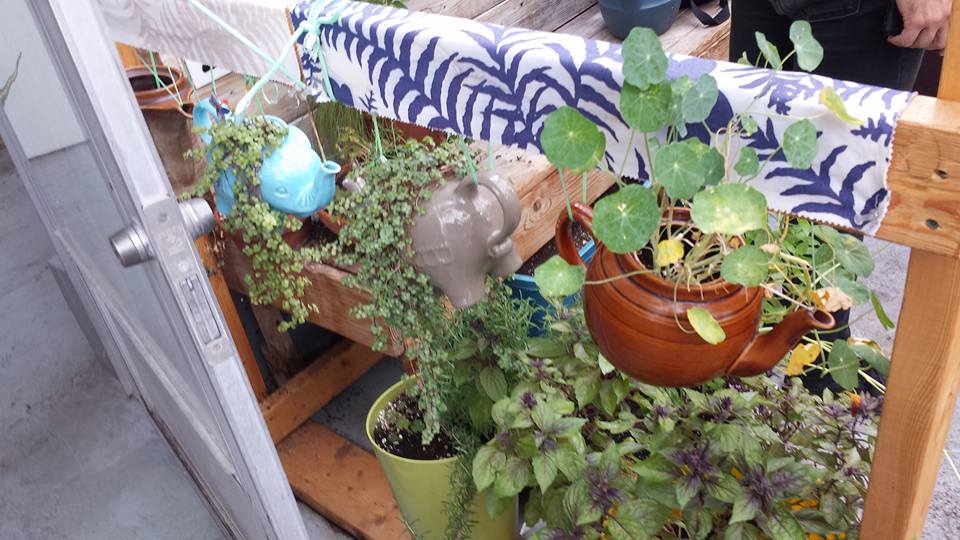
Today we began at the Concordia downtown campus. If you take to elevator to the 12th floor, and proceed up one additional flight of stairs, you will arrive at the Concordia Green House (our guide, Sheena, shared anecdotes about the how superstitions about elevators can present quite a nuisance to staff and volunteers who are tasked with hauling gear up to the 13th floor). Despite our 9:00am start, the rooftop greenhouse was already warm and humid.
The Concordia Greenhouse was initially a place for biological experimentation. After the construction of a new lab, it was slated for demolition. Students from Sustainable Concordia and the Geography Department successfully organized an effort to preserve the space. What resulted was a place, open to the public, with demonstration rooms and a variety of workshops. One such room within the greenhouse was demonstrating what plants to use in a balcony garden, using found and reclaimed materials.
Our next stop was Concordia’s Layola campus, where we explored the City Farm School. Here we explored a collectively managed and semi-autonomous garden that is largely worked by 45 UA interns and two full time staff. Here too was the theme of using found objects. In fact, interns were not allowed to use purchased materials when planning their gardens—a fact we confirmed through identifying several hockey stick posts. Once again, the theme of education and public outreach predominated this farm’s mission. Through workshops, seed sales, and the Concordia Farmers Market, they are able to impact about 900 residents.
Next stop was a UdeM project called PAUSE (Production Agricole Urbaine Soutenable Écologique). We were excited to see Alexandre Beaudoin again (from Miel Montréal) as he led us across the campus in the shadow of the mountain. UdeM is a conservation site, and while that is certainly a good thing, it presents Alexandre with some interesting predicaments—whether that is needing 6 weeks of processing time in order to pull a permit to plant trees, or 6 months to deal with a troublesome marmot. This tension and bureaucratic sluggishness is often the central conflict in many of Alexandre’s projects. As he shared:
“In sustainable development we are always trying to do new things, and people who are in administration, they like to have things always be the same.”
Despite these two conflicting processes, what PAUSE has accomplished with the variety and extant of the plots was impressive. From the Nourishing Forest (a contemplative wooded path through edible plantings), or the hop trellises that will be used to make neighborhood specific beer for the 350th anniversary of the City of Montreal, to the bee boxes set up adjacent to a crop of the three sisters (squash, maize, and beans), we were shown a variety of sites that are a viable part of the university community.
-Amanda
The Concordia Greenhouse was initially a place for biological experimentation. After the construction of a new lab, it was slated for demolition. Students from Sustainable Concordia and the Geography Department successfully organized an effort to preserve the space. What resulted was a place, open to the public, with demonstration rooms and a variety of workshops. One such room within the greenhouse was demonstrating what plants to use in a balcony garden, using found and reclaimed materials.
Our next stop was Concordia’s Layola campus, where we explored the City Farm School. Here we explored a collectively managed and semi-autonomous garden that is largely worked by 45 UA interns and two full time staff. Here too was the theme of using found objects. In fact, interns were not allowed to use purchased materials when planning their gardens—a fact we confirmed through identifying several hockey stick posts. Once again, the theme of education and public outreach predominated this farm’s mission. Through workshops, seed sales, and the Concordia Farmers Market, they are able to impact about 900 residents.
Next stop was a UdeM project called PAUSE (Production Agricole Urbaine Soutenable Écologique). We were excited to see Alexandre Beaudoin again (from Miel Montréal) as he led us across the campus in the shadow of the mountain. UdeM is a conservation site, and while that is certainly a good thing, it presents Alexandre with some interesting predicaments—whether that is needing 6 weeks of processing time in order to pull a permit to plant trees, or 6 months to deal with a troublesome marmot. This tension and bureaucratic sluggishness is often the central conflict in many of Alexandre’s projects. As he shared:
“In sustainable development we are always trying to do new things, and people who are in administration, they like to have things always be the same.”
Despite these two conflicting processes, what PAUSE has accomplished with the variety and extant of the plots was impressive. From the Nourishing Forest (a contemplative wooded path through edible plantings), or the hop trellises that will be used to make neighborhood specific beer for the 350th anniversary of the City of Montreal, to the bee boxes set up adjacent to a crop of the three sisters (squash, maize, and beans), we were shown a variety of sites that are a viable part of the university community.
-Amanda
 RSS Feed
RSS Feed
